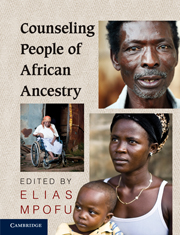Book contents
- Frontmatter
- Contents
- Contributors
- About the Editor
- Editorial Board
- Foreword
- Preface
- Acknowledgments
- PART 1 FOUNDATIONS OF COUNSELING IN AFRICAN SETTINGS
- PART 2 CONTEXTS OF COUNSELING
- 7 School Counseling
- 8 Counseling Students at Tertiary Institutions
- 9 Family Therapy within the African Context
- 10 Pastoral Care and Counseling
- 11 African Refugees: Challenges and Prospects of Resettlement Programs
- 12 Counseling Orphans and Vulnerable Children in Africa
- 13 Diversity Counseling with African Americans
- 14 Resolving Conflict in Africa: In Search of Sustainable Peace
- PART 3 COUNSELING APPLICATIONS
- PART 4 THE FUTURE OF COUNSELING IN AFRICAN HERITAGE SETTINGS
- Counseling People of African Ancestry Multiple Choice Answers
- Index
13 - Diversity Counseling with African Americans
Published online by Cambridge University Press: 05 August 2011
- Frontmatter
- Contents
- Contributors
- About the Editor
- Editorial Board
- Foreword
- Preface
- Acknowledgments
- PART 1 FOUNDATIONS OF COUNSELING IN AFRICAN SETTINGS
- PART 2 CONTEXTS OF COUNSELING
- 7 School Counseling
- 8 Counseling Students at Tertiary Institutions
- 9 Family Therapy within the African Context
- 10 Pastoral Care and Counseling
- 11 African Refugees: Challenges and Prospects of Resettlement Programs
- 12 Counseling Orphans and Vulnerable Children in Africa
- 13 Diversity Counseling with African Americans
- 14 Resolving Conflict in Africa: In Search of Sustainable Peace
- PART 3 COUNSELING APPLICATIONS
- PART 4 THE FUTURE OF COUNSELING IN AFRICAN HERITAGE SETTINGS
- Counseling People of African Ancestry Multiple Choice Answers
- Index
Summary
OVERVIEW. As a group, African Americans are heterogeneous with a multiplicity of racial compositions largely comprising involuntary immigrants to the United States from Africa, the Caribbean, Latin America, and Europe (Mpofu, 2005). Understanding the diversity that exists within the African American population, their position as one of the historical racial minority groups in the United States, and their unique cultural orientation and values are prerequisites to understanding the emotional consequences of race in the counseling process. This chapter presents an introspection of therapeutic counseling for people of African descent with a focus on African Americans. The multicultural movement in counseling began approximately forty years ago, and gained momentum from observations that clients from minority groups received unequal and poor counseling services (Patterson, 1996). During the past two decades, the counseling literature has increasingly included multicultural counseling. This inclusion, however, has been in part perfunctory, and too infrequently resiliency and strengths-based foci have not been included (Harley & Dillard, 2005). The multicultural movement shaping the United States needs to take place at two levels. On the first level, the United States is coming to recognize, learn about, and appreciate the cultural diversity within the country and among racial, ethnic, and cultural groups that make up its population. On the second level, the United States also needs a global perspective that recognizes and is open to other cultures in other countries (Leong & Blustein, 2000; Monk, Winslade, & Sinclair, 2008).
- Type
- Chapter
- Information
- Counseling People of African Ancestry , pp. 193 - 208Publisher: Cambridge University PressPrint publication year: 2011
- 1
- Cited by



